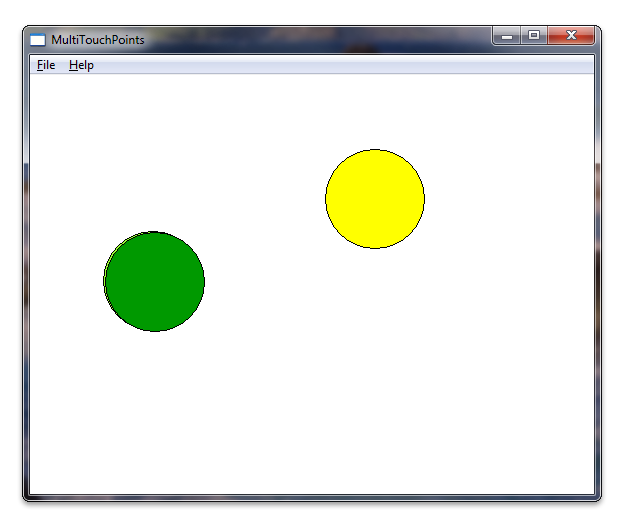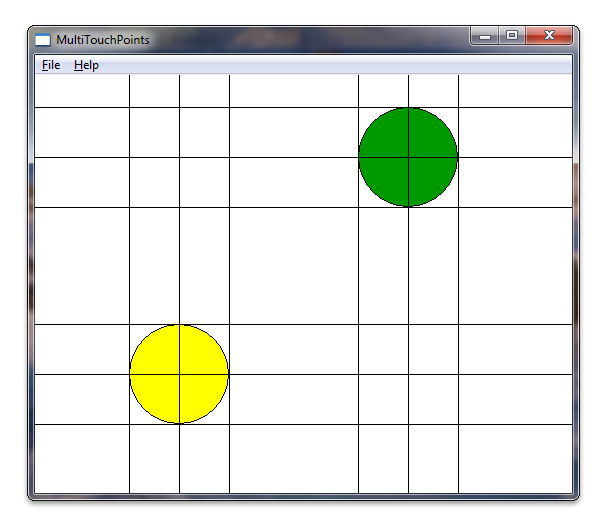여러 터치 포인트 검색 및 추적
다음 단계에서는 Windows Touch를 사용하여 여러 터치 포인트를 추적하는 방법을 설명합니다.
- 애플리케이션을 만들고 Windows Touch를 사용하도록 설정합니다.
- WM_TOUCH 및 트랙 지점에 대한 처리기를 추가합니다.
- 점을 그립니다.
애플리케이션을 실행한 후에는 각 터치에서 원을 렌더링합니다. 다음 스크린샷은 실행하는 동안 애플리케이션의 모양을 보여 줍니다.

애플리케이션 만들기 및 Windows Touch 사용
Microsoft Visual Studio 마법사를 사용하여 Microsoft Win32 애플리케이션으로 시작합니다. 마법사를 완료한 후 targetver.h에서 Windows 버전을 설정하고 애플리케이션에 windows.h 및 windowsx.h를 포함하여 Windows Touch 메시지에 대한 지원을 추가합니다. 다음 코드에서는 targetver.h에서 Windows 버전을 설정하는 방법을 보여 줍니다.
#ifndef WINVER // Specifies that the minimum required platform is Windows 7.
#define WINVER 0x0601 // Change this to the appropriate value to target other versions of Windows.
#endif
#ifndef _WIN32_WINNT // Specifies that the minimum required platform is Windows 7.
#define _WIN32_WINNT 0x0601 // Change this to the appropriate value to target other versions of Windows.
#endif
#ifndef _WIN32_WINDOWS // Specifies that the minimum required platform is Windows 98.
#define _WIN32_WINDOWS 0x0410 // Change this to the appropriate value to target Windows Me or later.
#endif
#ifndef _WIN32_IE // Specifies that the minimum required platform is Internet Explorer 7.0.
#define _WIN32_IE 0x0700 // Change this to the appropriate value to target other versions of IE.
#endif
다음 코드에서는 include 지시문을 추가하는 방법을 보여 줍니다. 또한 나중에 사용할 일부 전역 변수를 만들 수 있습니다.
#include <windows.h> // included for Windows Touch
#include <windowsx.h> // included for point conversion
#define MAXPOINTS 10
// You will use this array to track touch points
int points[MAXPOINTS][2];
// You will use this array to switch the color / track ids
int idLookup[MAXPOINTS];
// You can make the touch points larger
// by changing this radius value
static int radius = 50;
// There should be at least as many colors
// as there can be touch points so that you
// can have different colors for each point
COLORREF colors[] = { RGB(153,255,51),
RGB(153,0,0),
RGB(0,153,0),
RGB(255,255,0),
RGB(255,51,204),
RGB(0,0,0),
RGB(0,153,0),
RGB(153, 255, 255),
RGB(153,153,255),
RGB(0,51,153)
};
WM_TOUCH 및 트랙 지점에 대한 처리기 추가
먼저 WndProc에서 WM_TOUCH 처리기에서 사용하는 일부 변수를 선언합니다.
int wmId, wmEvent, i, x, y;
UINT cInputs;
PTOUCHINPUT pInputs;
POINT ptInput;
이제 터치 포인트를 저장하는 데 사용되는 변수를 초기화하고 InitInstance 메서드의 터치 입력 창을 등록합니다.
BOOL InitInstance(HINSTANCE hInstance, int nCmdShow)
{
HWND hWnd;
hInst = hInstance; // Store instance handle in our global variable
hWnd = CreateWindow(szWindowClass, szTitle, WS_OVERLAPPEDWINDOW,
CW_USEDEFAULT, 0, CW_USEDEFAULT, 0, NULL, NULL, hInstance, NULL);
if (!hWnd) {
return FALSE;
}
// register the window for touch instead of gestures
RegisterTouchWindow(hWnd, 0);
// the following code initializes the points
for (int i=0; i< MAXPOINTS; i++){
points[i][0] = -1;
points[i][1] = -1;
idLookup[i] = -1;
}
ShowWindow(hWnd, nCmdShow);
UpdateWindow(hWnd);
return TRUE;
}
다음으로 WndProc 메서드에서 WM_TOUCH 메시지를 처리합니다. 다음 코드는 WM_TOUCH 대한 처리기의 구현을 보여 주는 코드입니다.
case WM_TOUCH:
cInputs = LOWORD(wParam);
pInputs = new TOUCHINPUT[cInputs];
if (pInputs){
if (GetTouchInputInfo((HTOUCHINPUT)lParam, cInputs, pInputs, sizeof(TOUCHINPUT))){
for (int i=0; i < static_cast<INT>(cInputs); i++){
TOUCHINPUT ti = pInputs[i];
index = GetContactIndex(ti.dwID);
if (ti.dwID != 0 && index < MAXPOINTS){
// Do something with your touch input handle
ptInput.x = TOUCH_COORD_TO_PIXEL(ti.x);
ptInput.y = TOUCH_COORD_TO_PIXEL(ti.y);
ScreenToClient(hWnd, &ptInput);
if (ti.dwFlags & TOUCHEVENTF_UP){
points[index][0] = -1;
points[index][1] = -1;
// Remove the old contact index to make it available for the new incremented dwID.
// On some touch devices, the dwID value is continuously incremented.
RemoveContactIndex(index);
}else{
points[index][0] = ptInput.x;
points[index][1] = ptInput.y;
}
}
}
InvalidateRect(hWnd, NULL, FALSE);
}
// If you handled the message and don't want anything else done with it, you can close it
CloseTouchInputHandle((HTOUCHINPUT)lParam);
delete [] pInputs;
}else{
// Handle the error here
}
이제 사용자가 화면을 터치하면 터치하는 위치가 포인트 배열에 저장됩니다. TOUCHINPUT 구조체의 dwID 멤버는 하드웨어에 종속되는 식별자를 저장합니다.
하드웨어에 종속되는 dwID 멤버의 문제를 해결하기 위해 WM_TOUCH 사례 처리기는 TOUCHINPUT 구조체의 dwID 멤버를 화면에 그려진 지점에 매핑하는 함수 GetContactIndex를 사용합니다. 다음 코드는 이 함수의 구현을 보여줍니다.
// This function is used to return an index given an ID
int GetContactIndex(int dwID){
for (int i = 0; i < MAXPOINTS; i++) {
if (idLookup[i] == dwID) {
return i;
}
}
for (int i = 0; i < MAXPOINTS; i++) {
if (idLookup[i] == -1) {
idLookup[i] = dwID;
return i;
}
}
// Out of contacts
return -1;
}
// Mark the specified index as initialized for new use
BOOL RemoveContactIndex(int index) {
if (index >= 0 && index < MAXPOINTS) {
idLookup[index] = -1;
return true;
}
return false;
}
Important
Windows 11 이상
일부 3-4-손가락 터치 조작은 기본적으로 Windows 앱에서 더 이상 작동하지 않습니다.
기본적으로 창을 전환하거나 최소화하고 가상 데스크톱을 변경하는 등의 작업을 위해 시스템에서 세 손가락 및 네 손가락 터치 조작을 사용합니다. 이제 이러한 조작이 시스템 수준에서 처리되기 때문에 이러한 변경으로 인해 앱 기능이 영향을 받을 수 있습니다.
애플리케이션 내에서 세 손가락 및 네 손가락 조작을 지원하기 위해 시스템에서 이러한 조작을 처리할지 여부를 지정하는 새로운 사용자 설정이 도입되었습니다.
Bluetooth 및 디바이스 > 터치 > "세 손가락 및 네 손가락 터치 제스처"
“켜짐”(기본값)으로 설정된 경우 시스템은 3 손가락 및 4 손가락 조작을 모두 처리합니다. 앱에서는 이러한 기능을 지원할 수 없습니다.
“꺼짐”으로 설정되면 앱에서 3 손가락 및 4 손가락 조작을 지원할 수 있습니다. 이러한 조작은 시스템에서 처리되지 않습니다.
애플리케이션에서 이러한 조작을 지원해야 하는 경우 이 설정을 사용자에게 알리고 해당 페이지에 설정 앱을 시작하는 링크를 제공하는 것이 좋습니다(ms-settings:devices-touch). 자세한 내용은 시작 관리자 참조하세요. LaunchUriAsync 메서드.
점 그리기
그리기 루틴에 대해 다음 변수를 선언합니다.
// For double buffering
static HDC memDC = 0;
static HBITMAP hMemBmp = 0;
HBITMAP hOldBmp = 0;
// For drawing / fills
PAINTSTRUCT ps;
HDC hdc;
HBRUSH hBrush;
// For tracking dwId to points
int index;
메모리 디스플레이 컨텍스트 memDC는 렌더링된 디스플레이 컨텍스트인 hdc와 교환되는 임시 그래픽 컨텍스트를 저장하여 깜박임을 제거하는 데 사용됩니다. 저장한 점을 사용하고 점에 원을 그리는 그리기 루틴을 구현합니다. 다음 코드에서는 WM_PAINT 처리기를 구현하는 방법을 보여줍니다.
case WM_PAINT:
hdc = BeginPaint(hWnd, &ps);
RECT client;
GetClientRect(hWnd, &client);
// start double buffering
if (!memDC){
memDC = CreateCompatibleDC(hdc);
}
hMemBmp = CreateCompatibleBitmap(hdc, client.right, client.bottom);
hOldBmp = (HBITMAP)SelectObject(memDC, hMemBmp);
hBrush = CreateSolidBrush(RGB(255, 255, 255));
FillRect(memDC, &client, hBrush);
DeleteObject(hBrush);
//Draw Touched Points
for (i=0; i < MAXPOINTS; i++){
hBrush = CreateSolidBrush(colors[i]);
SelectObject( memDC, hBrush);
x = points[i][0];
y = points[i][1];
if (x >0 && y>0){
Ellipse(memDC, x - radius, y - radius, x+ radius, y + radius);
}
DeleteObject(hBrush);
}
BitBlt(hdc, 0,0, client.right, client.bottom, memDC, 0,0, SRCCOPY);
EndPaint(hWnd, &ps);
SelectObject(memDC, hOldBmp);
DeleteObject(hMemBmp);
break;
애플리케이션을 실행할 때 이제 이 섹션의 시작 부분에 있는 그림과 같이 표시됩니다.
재미를 위해 터치 포인트 주위에 몇 가지 추가 선을 그릴 수 있습니다. 다음 스크린샷에서는 원 주위에 몇 개의 추가 선이 그려져 애플리케이션이 어떻게 보이는지 보여 줍니다.
